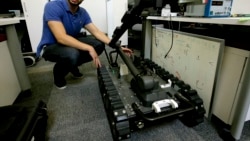ອຸດສາຫະກຳກໍ່ສ້າງກຳລັງຄົ້ນພົບການໃຊ້ງານໃໝ່. ສຳລັບປັນຍາປະດິດໃນໂຄງ ການກໍ່ສ້າງອາຄານຫຼາຍຊັ້ນໃນນະຄອນ ຊີອາໂທ (ທີ່ຢູ່ພາກຕາເວັນຕົກສຽງ ເໜືອຂອງສະຫະລັດ), ຫຸ່ນຍົນອັດຕະໂນມັດໄດ້ຮັບຄຳສັ່ງໃຫ້ບັນທຶກຄວາມຄືບ ໜ້າ ແລະ ກວດຈັບອັນຕະລາຍທີ່ອາດຈະເກີດຂຶ້ນ. ນັກຂ່າວວີໂອເອ ນາຕາຊາ ມອດສໂກວາຍາ ມີລາຍງານ, ເຊິ່ງ ພຸດທະສອນ ຈະນຳລາຍລະອຽດມາສະເໜີທ່ານໃນອັນດັບຕໍ່ໄປ.
ເມື່ອທີມກໍ່ສ້າງອາຄານອາພາດເມັນໃນນະຄອນ ຊີອາໂທ, ລັດວໍຊິງຕັນ, ເລີກວຽກໃນແຕ່ລະມື້, ຫຸ່ນຍົນອັດຕະໂນມັດສອງໂຕທີ່ຂັບເຄື່ອນດ້ວຍປັນຍາປະດິດ ຫຼື Ai ຈະເລີ່ມເຮັດວຽກ.
ທ່ານ ສຈວດ ເຈີເມນ, ຜູ້ອຳນວຍການຝ່າຍນະວັດຕະກຳຂອງ Skanska - ບໍລິສັດກໍ່ສ້າງທີ່ນຳເອົາຫຸ່ນຍົນມານຳໃຊ້ກ່າວວ່າ
"ຫຸ່ນຍົນຈະຂັບເຄື່ອນເຂົ້າໄປໃນແຕ່ລະຫ້ອງເຖິງພື້ນ. ມັນມີແຜນຜັງຊັ້ນທີ່ໂຫລດໄວ້ແລ້ວ, ດັ່ງນັ້ນມັນຈຶ່ງຮູ້ວ່າຝາຈະຢູ່ບ່ອນໃດ. ສິ່ງທີ່ມັນຈະເຮັດຄືເຄື່ອນທີ່ເຂົ້າໄປໃນແຕ່ລະພື້ນທີ່ ແລະ ຖ່າຍຮູບຄວາມລະອຽດສູງແບບ 360 ອົງສາ. ມັນຈະເຮັດແບບນີ້ໝົດທຸກຊັ້ນ. ຈາກນັ້ນຈະອັບໂຫລດພາບເຫຼົ່ານັ້ນໄປເຖິງພື້ນທີ່ເກັບຄວາມຈຳອອນລາຍ (cloud-based platform), ເຊິ່ງມັນຈະປະມວນຜົນຜ່ານການວິເຄາະທີ່ຂັບເຄື່ອນດ້ວຍ Ai ຫຼາຍຮູບແບບ ແລ້ວລາຍງານຜົນໄປໃຫ້ທີມໂຄງການ."
ເມື່ອຫຸ່ນຍົນຖືກແນະນຳໃຫ້ກັບພະນັກງານເມື່ອສາມເດືອນທີ່ຜ່ານມາ ໃນຖານະສ່ວນໜຶ່ງຂອງໂຄງ ການທົດລອງການຮ່ວມມືລະຫວ່າງບໍລິສັດກໍ່ສ້າງ Skanska ແລະ Nextera Robotics ທີ່ຕັ້ງຢູ່ໃນນະຄອນ ບັອສຕັນ, ບາງຄົນຍັງມີຄວາມສົງໃສ.
ທ່ານ ແກເຣັດ ເມັດຊ, ວິສະວະກອນໂຄງການອາວຸໂສຂອງ Skanska ກ່າວວ່າ
"ຕອນທຳອິດຂ້ອຍກໍ່ບໍ່ແນ່ໃຈວ່າພວກມັນຈະສາມາດນຳທາງໃນໂຄງການໄດ້ ດ້ວຍຕົນເອງ. ຂ້ອຍບໍ່ເຄີຍເຫັນຫຸ່ນຍົນທີ່ສາມາດເຄື່ອນທີ່ໄປຮອບໆ ບໍລິເວນກໍ່ສ້າງທີ່ປ່ຽນແປງຢູ່ຕະຫຼອດເວລາໄດ້ໂດຍອັດຕະໂນມັດ. ມີສິ່ງກີດຂວາງຢູ່ຕະຫຼອດ. ມີຄົນຍ່າງເຂົ້າອອກຕະຫຼອດເວລາ. ແຕ່ພວກນີ້ເຮັດວຽກໄດ້ດີຫຼາຍໃນເລື່ອງນັ້ນ."
ຮູບພາບທີ່ຖ່າຍໂດຍຫຸ່ນຍົນເຫຼົ່ານີ້ຈະຜ່ານໂມເດວ Ai ທີ່ໄດ້ຮັບການຝຶກໃຫ້ຮັບຮູ້ວັດຖຸທີ່ກ່ຽວຂ້ອງກັບການກໍ່ສ້າງປະມານໜຶ່ງພັນກວ່າລາຍການ ເພື່ອໃຫ້ວິສະວະກອນໃນເຂດກໍ່ສ້າງ ແລະ ນັກອອກແບບທີ່ຝັ່ງຢູ່ກົງກັນຂ້າມ ສາມາດກວດສອບຄວາມຄືບໜ້າຂອງການກໍ່ສ້າງ ແລະ ລະບຸອັນຕະລາຍທີ່ອາດຈະເກີດຂຶ້ນໄດ້.
ທ່ານເຈຄອບ ໄຣອັລ, ຜູ້ຈັດການຝ່າຍປະຕິບັດການຂອງ Nextera Robotics ກ່າວວ່າ
"ມັນກຳລັງວິເຄາະ ແລະ ບອກວ່າ, ໂອເຄ, ຂ້ອຍເຫັນຫຍັງແນ່ບ່ອນນີ້? ຝາຖືກທາສີ ຫຼື ເປັນແຜ່ນຍິບຊຳ? ເພດານມີໂຄງ ຫຼືບໍ່? ເປັນຄອນກີດທີ່ທາສີແລ້ວຫຼືບໍ່? ຕິດຕັ້ງທໍ່ລົມແລ້ວຫຼືຫຍັງ? ທໍ່ລົມມີສະນວນແລ້ວບໍ່? ມັນເບິ່ງຫາສິ່ງເຫຼົ່ານີ້ທັງໝົດແລ້ວປະມວນຜົນລົງໃນພື້ນທີ່ເກັບຄວາມຈຳອອນລາຍຂອງພວກເຮົາ ຈາກນັ້ນກໍ່ສະແດງຜົນໃນຮູບແບບທີ່ເຂົ້າໃຈໄດ້ງ່າຍຫຼາຍ."
ໃບໜ້າຂອງຄົນງານຈະຖືກເຮັດໃຫ້ເປັນພາບມົວ ໃນຮູບພາບທີ່ຫຸ່ນຍົນຖ່າຍ ເພື່ອປົກປ້ອງຄວາມເປັນສ່ວນໂຕຂອງພວກເຂົາ.
ຜູ້ນຳໂຄງການຢືນຍັນວ່າຫຸ່ນຍົນທີ່ຢູ່ທີ່ນັ້ນແມ່ນມາເພື່ອຊ່ວຍເຫຼືອຜູ້ຄົນໃນວຽກທີ່ໜ້າເບື່ອ ຫຼື ອັນຕະລາຍ, ບໍ່ໄດ້ມາເພື່ອມາຍາດວຽກຂອງພວກເຂົາ.
ທ່ານ ສະຈວດ ເຈີເມນ ກ່າວວ່າ
"ຫຸ່ນຍົນຊ່ວຍປະຢັດເວລາຂອງຄົນໄດ້ຫຼາຍ ເພາະເວລາທີ່ຄົນຈະຕ້ອງໃຊ້ໃນການຍ່າງຖ່າຍຮູບໃຫ້ໄດ້ລະດັບຄວາມສະໝ່ຳສະເໝີແບບນີ້ ຈະຕ້ອງໃຊ້ເວລາຫຼາຍກວ່າ 40 ຊົ່ວໂມງຕໍ່ອາທິດ."
ທ່ານ ເຈຄອບ ກ່າວວ່າ
"ການທີ່ສາມາດຕິດຕາມຄວາມຄືບໜ້າໃນທຸກດ້ານຂອງອາຄານທີ່ພັກອາໄສ 31 ຊັ້ນ, 324 ໜ່ວຍ ເຊັ່ນທີ່ຊີອາໂທ <..> ນັ້ນເປັນສິ່ງທີ່ຈະຕ້ອງໃຊ້ເວລາຫຼາຍ ແລະ ຍາກຫຼາຍສຳລັບມະນຸດທີ່ຈະເຮັດ."
ເຖິງແມ່ນວ່າຈະມີປະໂຫຍດຈາກເຕັກໂນໂລຢີ, ບໍລິສັດກໍ່ສ້າງກໍ່ຍັງຊ້າໃນການປັບຕົວໃນການໃຊ້ເຄື່ອງມື Ai - ແຕ່ທ່ານ ເຈີເມນ ຄິດວ່າສິ່ງນີ້ຈະມີການປ່ຽນແປງ.
ທ່ານ ສຈວດ ກ່າວວ່າ "ອຸດສາຫະກຳກໍ່ສ້າງພ້ອມທີ່ຈະນໍາເອົາຫຸ່ນຍົນເຂົ້າມາໃຊ້ຫຼາຍຂຶ້ນໃນອະນາຄົດ ຂ້ອຍຄິດມາສະເໝີວ່າຫຸ່ນຍົນຈະເຮັດວຽກຮ່ວມກັບມະນຸດໃນເຂດກໍ່ສ້າງໄດ້, ທັງໃນຖານະເຄື່ອງມື ແລະ ສິ່ງທີ່ເປັນປະໂຫຍດ. ຂ້ອຍບໍ່ຄິດວ່າພວກມັນຈະເຂົ້າມາຄວບຄຸມຂະບວນການກໍ່ສ້າງດ້ວຍຕົນເອງໃດ"
ທ່ານເຈີເມນ ກ່າວວ່າການນຳ Ai ມາໃຊ້ຢ່າງກວ້າງຂວາງສຳລັບການເພີ່ມປະສິດທິພາບຂອງຂະບວນການ, ຂໍ້ມູນລະອຽດໃນເວລາຕົວຈິງ ແລະ ການປະເມີນຄວາມສ່ຽງໃນການກໍ່ສ້າງ ເປັນພຽງເລື່ອງຂອງເວລາເທົ່ານັ້ນ.
ອ່ານລາຍງານນີ້ເປັນພາສາອັງກິດ
When the construction crew on this Seattle, Washington, apartment building clocks out for the day, two autonomous robots backed by artificial intelligence — or AI — get to work.
"So the robot drives into each room on the floor. It has the floor plans already loaded in it, so it knows where the walls are going to be. And what it does is it moves into each space and takes a 360-degree high resolution photo. And it goes through, and it does the entire floor for that. And then it uploads those photos into its cloud-based platform, where it runs through a number of AI-driven analyses that then report out to the project team."
When the robots were introduced to the staff three months ago as part of a pilot project collaboration between the Skanska construction company and Boston-based Nextera Robotics, some were skeptical.
"I initially was not sure if they were going to be able to navigate the project by themselves. I have not seen a robot that's able to autonomously kind of maneuver around a construction site that's ever-changing. There's always things in the way. There's always people moving in and out. But these do a really good job at that."
Images captured by these robots go through an AI model trained to recognize ((end courtesy)) thousands of construction-related objects so engineers on site and designers on the opposite coast can monitor the building progress and identify potential hazards.
"It's analyzing them and saying, okay, what do I see here? <..> Are the walls painted or is it drywall? Do the ceilings have framing? Is it painted concrete? Is the air duct installed? Is the air duct insulated? It's looking for all of these things and then processing them into our online platform and then displaying them in a really digestible way."
Workers' faces are blurred on the robot-captured images to protect their privacy.
Project leaders insist that the robots are there to help people with tedious or dangerous tasks, not take their jobs.
"The robot saves a lot of person time just because the amount of time it would take a human to come through and take the level of photos with the consistency is more than 40 hours a week."
"Being able to track the progress amongst all the trades on a 31-story, 324-unit residential tower such as the one in Seattle, <..> that's just something that would be extremely time-consuming and very, very difficult for a human to do."
Despite the technology's benefits, construction companies have been slow in adapting the AI tools – but Germain thinks this will change.
"The construction industry is ripe for much more inclusion of robotics in the future. <..> I think that robots will always be working hand in hand with the humans on the job sites, as a tool and a benefit. I don't think that they're going to be, you know, taking over the construction process on their own."
Germain says that the wider adoption of AI for process optimization, real-time insights and risk assessment in construction is just a matter of time.







ຟໍຣັມສະແດງຄວາມຄິດເຫັນ